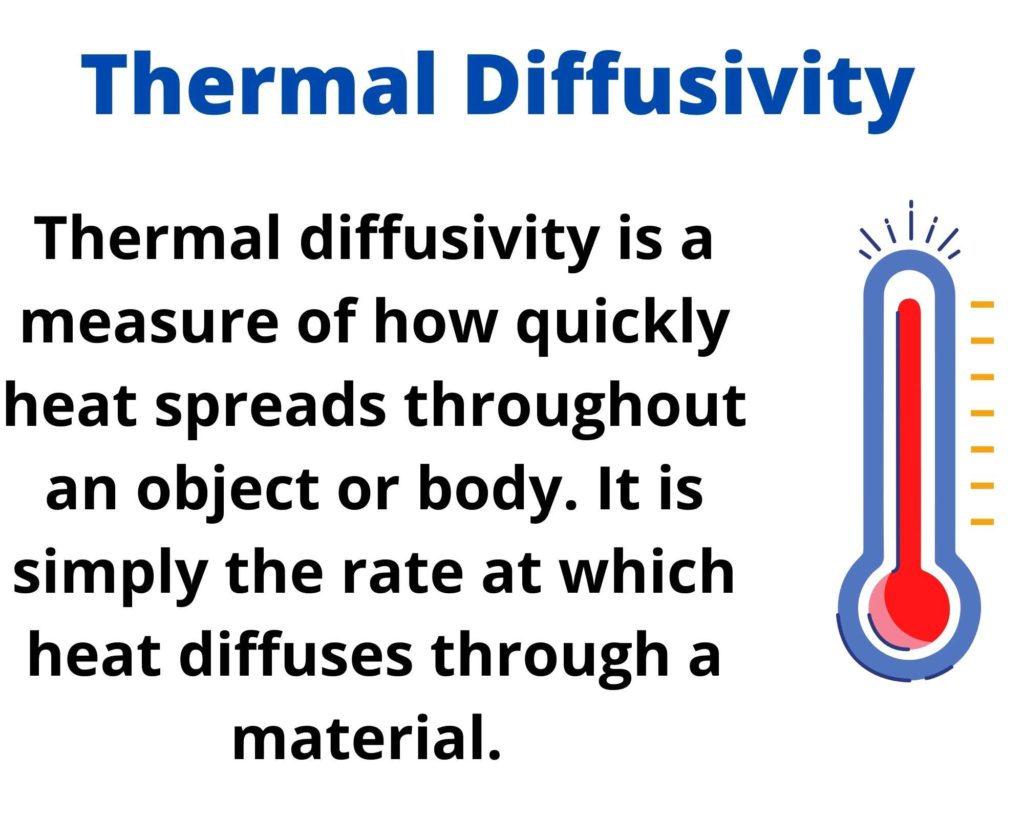Thermal diffusivity is a measure of how quickly heat spreads throughout an object or body. It is simply the rate at which heat diffuses through a material. Furthermore, thermal diffusivity is different from thermal conductivity as thermal conductivity is a measurement of how easily one atom or molecule of a material accepts or emits heat.

If the density is known, thermal diffusivity can be measured alongside thermal conductivity. Searle’s bar experiment, which yields a thermal conductivity equation, is one method. For experimental setup and detailed calculations, please check this link “Searle’s Apparatus and calculations”.
Modern technological advancements have resulted in more accurate methods for determining an object’s thermal diffusivity. The flash method is a new way of measuring thermal diffusivity. In this method, a small sample of the material with predetermined dimensions is coated in black paint, which causes the sample to behave like a black box. The sample’s face is then struck with a brief burst of extremely bright light. The amount of energy imparted into the sample can be easily estimated with high accuracy by knowing the wavelength and intensity of this light. The sample’s opposite face comes into contact with a thermocouple, which measures the temperature of that face. An oscilloscope plots the measured temperature as a function of time. The thermal diffusivity can then be calculated by rearranging the heat equation based on the shape of the graph.
Table of Contents
Measurement of thermal diffusivity
Some techniques for measuring thermal diffusivity are the laser flash method, thermal wave interferometry, and infrared thermography.
The Laser Flash Method
This approach includes heating a plane-parallel sample material with a brief burst of energy on one side and measuring the temperature change on the other side. Time, temperature increase, and sample thickness would be among the metrics monitored. The drawback of this approach is that it necessitates the use of a sample with a certain shape.
Thermal wave interferometry
This approach is used to test the thermal diffusivity of coatings and thin slabs. The approach includes heating a coated sample with a modulated laser, and the sample’s two-layer structure causes a change in the ac component (phase and amplitude) of the surface temperature as compared to an uncoated surface. This variation is induced by the reflection and transmission of heatwaves at the sample’s interface between the coated and uncoated surfaces, which is monitored by an infrared detector. Thermal diffusivity is calculated using all of these data.
Infrared Thermography
This method investigates the temporal evolution of the temperature distribution of the rear surface of a plate-like sample heated from the front by an instantaneous circular Gaussian heat source. The temperature spatial distribution or phase image of either of the front or rear sample surfaces may then be used to compute thermal diffusivity. The thermographic approaches are as follows: spatially resolved diffusivity measurement, lateral thermal waves, and single-side flash.
Summary
- The concept of Thermal diffusivity is frequently confused with that of thermal conductivity.
- Thermal diffusivity plays an important role in influencing the movement and behavior of heat.
- Sealers apparatus or flash method can be used to measure the thermal diffusivity value of a material.
Related Topics
Heat Flux-An Overview
Thermite Welding- An Overview
Power Units- The Basics
Thermal Energy Equation- Simple Overview
Momentum Equation| Definition and Examples
Frequently Asked Questions
1. What is the difference between thermal conductivity and thermal diffusivity?
The major difference between thermal conductivity and diffusivity is that thermal conductivity relates to a material’s ability to transmit heat, whereas thermal diffusivity refers to the rate of heat transfer from its hot end to its cold end.
2. What is thermal diffusivity?
Thermal diffusivity is the rate at which temperature spreads across a substance. It is a method of measuring heat transfer in a material. It measures the heat transfer from hot to cold material.
3. Uniform circular motion Definition?
Uniform Circular Motion occurs when an object moves in a circular path at a constant speed. Examples. Moon’s Motion around the earth is an example of uniform circular motion.
4. What is a hydropower turbine?
Hydro turbines are equipment used in hydroelectric power plants to transport energy from flowing water to a rotating shaft in order to create electricity. When water is fed into the turbine’s blades, it causes it to revolve or spin.
5. Gamma decay definition?
One type of radioactive decay that a nucleus can experience is gamma decay. When this form of decay occurs, no particles are expelled from the nucleus.
6. light energy definition
Light is a kind of radiation that travels as electromagnetic waves. It may alternatively be represented as a flow of particle-like ‘wave-packets,’ known as photons, traveling at 300,000 kilometers per second.
The term energy of light refers to the energy of photons which is calculated by this equation, E = hf, where E is the energy of the photon in Joules; h is Planck’s constant, which is always 6.63 * 10-34 Joule seconds; and f is the frequency of the light in hertz.
7. Where is thermal diffusivity used?
Thermal diffusivity is a critical concept in the heat transmission process. Thermal diffusivity is the rate at which temperature spreads across a substance. It is a method of measuring heat transfer in a material. It measures the heat transfer from heat to cold material.
8. Work energy formula definition?
According to the work-energy theorem, the work done by the sum of all forces acting on an object equals the change in kinetic energy of the object (or) the net work done on a system equals the change in kinetic energy.
9. What is linear motion in simple words?
In layman’s terms, linear motion is movement along a straight line, whereas nonlinear motion is any movement that is not along a straight line. Linear motion could be uniform or non-uniform. Some examples of linear motion are a bullet fired from a gun, a ball falling from a cliff, and a person walking straight.
More Interesting Topics
What Temp Does Water Freeze?
The Melting Point of Water
Thermal Conductivity of Water
Is Nh3 Polar?
How Many Cups in a Gallon?
Is Titanium Magnetic?
Density of Water in g/ml-Accurate Value
The Density of Water lbs/U.S gal
O2 Lewis Structure & Molecular Geometry
Is HCl Polar or Nonpolar?
References
“Flash Method of Determining Thermal Diffusivity, Heat Capacity, and Thermal Conductivity” – W. J. Parker, R. J. Jenkins, C. P. Butler, and G. L. Abbott – Journal of Applied Physics 32, 1679 (1961); 10.1063/1.1728417 – https://aip.scitation.org/doi/abs/10.1063/1.1728417
“Thermal Diffusivity Mapping of Graphene-Based Polymer Nanocomposites” – Matthieu Gresil, Zixin Wang, Quentin-Arthur Poutrel & Constantinos Soutis – Scientific Reports | 7: 5536; 10.1038/s41598-017-05866-0 – https://www.nature.com/articles/s41598-017-05866-0.pdf
- BCl3 Lewis Structure in four simple steps - November 1, 2023
- PH3 Lewis Structure in four simple steps - October 8, 2023
- PF3 Lewis structure in four simple steps - September 24, 2023



